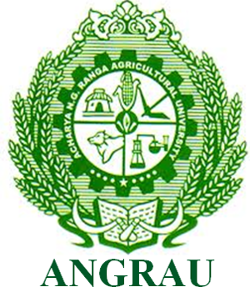Faunistic Studies on Economically Important Lepidopterans in Different Field Crops of Tirupati District
0 Views
P. PRAVALLIKA*, M.S.V. CHALAM, E. CHANDRAYUDU, P. LAVANYA KUMARI AND M. RAJASRI
Department of Entomology, S.V. Agricultural College, ANGRAU, Tirupati-517 502.
ABSTRACT
A study was conducted in the Department of Entomology, S.V. Agricultural College, Tirupati during the year 2023-
2024, on the chaetotaxy of larva and genital characters of adults. Larvae were collected from different field crops such as rice, sugarcane, maize, sorghum, ragi, groundnut, cotton, pulses and oilseeds. The collected larvae were brought to the laboratory and the taxonomic characters were studied in detail. Some of the larvae were reared until the adult emergence followed by dissection of genitalia in order to identify them easily. All these lepidopteran larvae were described based on the morphological characters and chaetotaxy of thoracic and abdominal segments especially 3rd abdominal segment and arrangement of crochets on the ventral prolegs. External morphology and genital characters viz., uncus, gnathos, tegumen in male genitalia and ovipositor, bursa copulatrix and apophyses of female genitalia. The photographs of head capsule, thorax, abdominal segments, depiciting the setal formula, crochets and genitalia were taken.
KEYWORDS: Chaetotaxy, Crochets, Genitalia, Noctuidae.
INTRODUCTION
Lepidoptera is the order of insects which includes butterflies and moths. It is one of the most diverse groups of insects, with around 1,80,000 species described worldwide. Most lepidopteran larvae are plant feeders and nectar feeding as adults, and they are a prominent element of terrestrial ecosystems, functioning as herbivores, pollinators and prey, as well as being one of the most damaging groups of pests to agriculture (Reiger et al. 2009). Major crops like Paddy, Sugarcane, Maize, Groundnut, Pulses etc., are infested by a number of Lepidopteran pests. Majority of the Lepidopteran pests which causes economic loss mainly feed on the plant parts like foliage, buds, blossoms, roots, stems causing considerable crop loss. The family Noctuidae of Lepidoptera is probably the largest macrolepidopteran family with more than 25,000 described species (Heppner, 1991). This family is economically important as it includes a number of serious pests of field crops, vegetables, ornamental plants etc. The species belonging to genera Spodoptera, Helicoverpa, Mythimna etc. cause heavy losses to different crops during their larval stages.
Theknowledgeonbiologyandaccurateidentification of a pest allows formulation of the management strategies effectively. Larval stages of these lepidopterous pests are economically significant as they are the damaging stages. Species affecting any crop is the first and foremost step in Integrated Pest Management. The identification of adult stage is easy but the destructive larval stages poses
considerable difficulties in their identification. Accurate identification of a pest species affecting any crop is the and foremost step in Integrated Pest Management.
MATERIAL AND METHODS
The larvae belonging to the order Lepidoptera of Family Noctuidae infesting different field crops like rice, maize, sugarcane, sorghum, ragi, cotton, pulses and oilseeds were collected. The collected larvae were taken to the laboratory. Some of the larvae were reared for emergence of adults. The collected larvae were killed with K.A.A.D mixture (kerosene-1 part, 95% ethyl alcohol-7 parts, dioxan-1 part and glacial acetic acid-2 parts). The killed larvae were immersed in 10 per cent solution of potassium hydroxide for maceration overnight, washed in water and passed through different grades of alcohol viz., 60, 80, 95 per cent consecutively for about 10-15 minutes to facilitate dehydration. The digested soft tissues were removed with the help of a pair of blunt needles and the specimens were transferred to clove oil for clearing. A 1:1 mixture of phenol + xylol was used to retain the specimens until the slides are prepared with Canada balsam permanently. The photographs of head capsule, thorax, abdominal segments, depicting the setal formula, crochets were taken with the help of photographic attachment in Olympus trinocular stereo zoom microscope.
Genitalia of adults (male and female) were dissected using the technique described by Clark (1941) and Kirti and Gill (2005) with little modification. Dried and preserved specimens were used for the study of genitalia. Before dissection of genitalia, adults were photographed. Then the abdomen was detached from thorax with the help of a fine needle. The abdomen was then transferred to a test tube containing a few milliliters of 10 per cent caustic potash (KOH). This was heated slowly in a water bath till the convection currents were observed in the solution and then it was kept for cooling. After cooling, the abdomen was transferred to a glass cavity dish containing 10% alcohol and the macerated soft tissues were pressed out with the help of a pair of bent needles mounted on plastic handles. After repeated washings in water, the genitalia is detached by cutting out intersegmental membrane. The genitalia which was dissected is then dehydrated in absolute alcohol for proper visualance of all the parts of genitalia. Later the dehydrated genitalia were mounted on a glass slide using coverslip with DPX mountant. These permanent slides were kept in hot air oven for drying. After the study, the dissected genitalia were preserved in slide boxes.
RESULTS AND DISCUSSION
In the present study species of family Noctuidae belonging to order Lepidoptera were collected viz., Tobacco caterpillar, Spodoptera litura; Gram pod borer Helicoverpa armigera, Castor semilooper, Achaea janata, Fall army worm Spodoptera frugiperda; Cotton spotted bollworm, Earias vittella; ragi pink stem borer, Sesamia inferens; Rice climbing cutworm, Mythimna separata.
A. Tobacco caterpillar, Spodoptera litura (Fabricius) (Plate 1)
Description of larvae: Colour of the larvae is generally brown, occasionally with a greenish blue shade. Larvae have a bright yellow or orange middorsal line, but also possess a less conspicuous subdorsal line marked by yellow or orange spots or dashes.
Chaetotaxy of prothorax and mesothorax
Prothorax: Prothoracic shield much chitinized, dark extended up to the margin of XD2. Dorsal setae D1 and D2, Anterior dorsal setae XD1 and XD2 are distinct and present on prothoracic shield. Lateral setae L1 and L2 present. Microscopic seta MV1 and ventral seta V1 present. Subventral setae SV1 and SV2 distinct.
Mesothorax: Dorsal setae D1 and D2 and subdorsal setae SD1 and SD2 distinct. Lateral setae L1, L2 and L3 present. Microscopic setae MV1 and MV2 present. Subventral seta SV1, ventral seta V1 distinct.
Abdomen: Abdomen ten segmented. Abdominal legs are fleshy, paired non-segmented which are called prolegs exists on 3rd, 4th, 5th, 6th and on last segments.
Eight pairs of spiracles present on first to eight abdominal segments.
Chaetotaxy of 3rdabdominal segment: Third abdominal segment is with dorsal setae D1 and D2. Subdorsal seta SD1 distinct. Lateral setae L1, L2 and L3 present below the spiracle. Ventral seta V1 present and subventral setae SV1, SV2 and SV3 distinct.
Crochets: Uniordinal mesoseries type of crochets are observed on abdominal prolegs.
Description of Adult: Adult moth is robust and large sized with dark wavy white markings on forewings and hindwing white in colour having a brown patch along its margin. In male genitalia, uncus is long and slightly curved in apical half, gradually narrowing toward pointed apex. Tegumen inverted V-shaped nearly equal to the length of uncus. In female genitalia, lobes of the ovipositor small, broad and setosed sparsely.
B. Gram pod borer, Helicoverpa armigera (Hubner) (Plate 2)
Description of larvae: Larvae is greenish in colour with coloured longitudinal stripes or dark grey lines present laterally on the body.
Chaetotaxy of prothorax and mesothorax Prothorax: Prothoracic shield much chitinized and
extended up to the margin of SD1. Dorsal setae D1 and D2 longer and anterior dorsal seta XD1, subdorsal setae SD1 and SD2 distinct. Lateral setae L1 and L2 present above the spiracle. Ventral seta V1 and microscopic setae MV1, MV2 present. Subventral setae SV1 and SV2 present.
Mesothorax: Microscopic seta MV1 present. Dorsal setae D1 and D2 and subdorsal setae SD1 and SD2 present. Lateral setae L1 and L2 distinct.
Abdomen: Abdomen ten segmented. Abdominal legs are fleshy, paired non-segmented which are called prolegs exists on 3rd, 4th, 5th, 6th and on last segments. Eight pairs of spiracles present on first to eight abdominal segments.
Chaetotaxy of 3rd abdominal segment: Dorsal setae D1, D2 and subdorsal seta SD1 distinct. Dorsal setae A1-A8 inserted on large conical chalazae, those of A1,
A2 or A8 often larger than the rest. Lateral seta L1 and L2 forewing. below the spiracle and ventral seta V1 present.
Crochets: Biordinal mesoseries type of crochets are observed on abdominal prolegs.
Description of Adult: Adult moths are robust and medium to large sized. Head is reddish brown in colour with greenish compound eyes. Forewings with 7-8 blackish spots on the margin and a broad, irregular, brown transverse band. Hindwings pale-straw coloured with a broad dark-brown border containing a paler patch, with yellowish margins. In male genitalia, uncus is singular and curved. Vesica without cornuti and with a terminal hook, surrounded by circlet of spines. In female genitalia, lobes of ovipositor are narrow, long and densely setose. Valve is longitudinally bifurcated and is elongated.
C. Castor semilooper, Achaea janata (Linnaeus) (Plate 3)
Description of larvae: Caterpillar is long and smooth, brownish to bluish grey in colour with black head. A red spot is present on the black loop which is formed due to the non-functional first pair of prolegs. Anal tubercles are red and prominent.
Chaetotaxy of prothorax and mesothorax Prothorax: Prothoracic shield much sclerotized
and extended upto the margin of SD1. Subdorsal setae SD1, SD2 and Dorsal setae D1, D2 distinct. Above the spiracle, Lateral setae L1 and L2 present. Ventral seta V1 distinct. Subventral setae SV1, SV2 and microscopic setae MV1 and MV2 present.
Mesothorax: Subdorsal setae SD1 and SD2 and Dorsal setae D1 and D2 distinct. Lateral setae L1, L2 and L3 present. Ventral seta V1 distinct.
Abdomen: Abdomen ten segmented. Abdominal legs are fleshy, paired non-segmented which are called prolegs exists on 4th, 5th, 6th and on last segments. Eight pairs of spiracles present on first to eight abdominal segments.
Chaetotaxy of 3rd abdominal segment: Dorsal setae D1 and D2 distinct. Around the spiracle, Lateral setae L1, L2 and L3 present. Subventral seta SV1 distinct.
Crochets: Uniordinal lateropenellipse type of crochets are observed on abdominal prolegs.
Description of Adult: Adult moth can be identified by the presence of an oblique white postmedial band on The hindwings are black with a medial white band and three large white spots on the outer margin. In male genitalia, uncus curved and strongly bifurcated with a well defined gnathos. In female genitalia, ovipositor lobes are smooth and elongated.
- The Fall army worm, Spodoptera frugiperda (J. E. Smith) (Plate 4)
Description of larvae: Larvae are yellowish, greenish or brownish in colour with white longitudinal stripes. Head black, brown and orange in colour, inverted Y shaped yellow band along the fronto- clypeal suture along the ecdysial line. Raised spots very prominent on the dorsal surface of mature larvae. Dots or spots are arranged in the form of square shape on the abdomen.
D.Chaetotaxy of prothorax and mesothorax
- The Fall army worm, Spodoptera frugiperda (J. E. Smith) (Plate 4)
Description of larvae: Larvae are yellowish, greenish or brownish in colour with white longitudinal stripes. Head black, brown and orange in colour, inverted Y shaped yellow band along the fronto- clypeal suture along the ecdysial line. Raised spots very prominent on the dorsal surface of mature larvae. Dots or spots are arranged in the form of square shape on the abdomen.
Chaetotaxy of prothorax and mesothorax
Prothorax: On first thoracic segment SD1 and SD2 setae present on a joint pinaculum ventral to thoracic shield. On prothoracic shield dorsal setae XD1, XD2 and dorsal setae D1, D2 present. L1 and L2 setae are hair like and situated on ventral margin of spiracular line. But the L3 setae is about half the length of L1 and L2.
Mesothorax: On meso and meta thoracic segments dorsal setae D1, D2 and sub dorsal setae SD1 and SD2 present. Lateral setae L1, L2, L3 present. Sub ventral setae SV1 situated on spiracular line. Spiracles are absent on meso and meta thoracic segments.
Abdomen: Abdomen ten segmented. Abdominal legs are fleshy, paired non-segmented which are called prolegs exists on 3rd, 4th, 5th, 6th and on last segments. Eight pairs of spiracles present on first to eight abdominal segments.
Chaetotaxy of 3rd abdominal segment: Third abdominal segment is with dorsal setae D1 and D2 that are arranged in trapezoidal pattern. Subdorsal setae SD1 present just above to the spiracle. Lateral setae L1, L2 and L3 present. Subventral setae SV1, SV2, SV3 distinct.
Crochets: Uniordinal mesoseries heteroideous type of crochets are observed on abdominal prolegs.
Description of Adult: Adult moth can be identified by the presence of distinct white patch at the apex of forewing and posses orbicular spot which is oval, cream- colored with a dull brown center, outlined in black. Dark grey spindle-shaped spots along the outer margin. Hindwings are Semi-hyaline. In male genitalia, uncus curved towards the apex, slender, and gradually narrowed
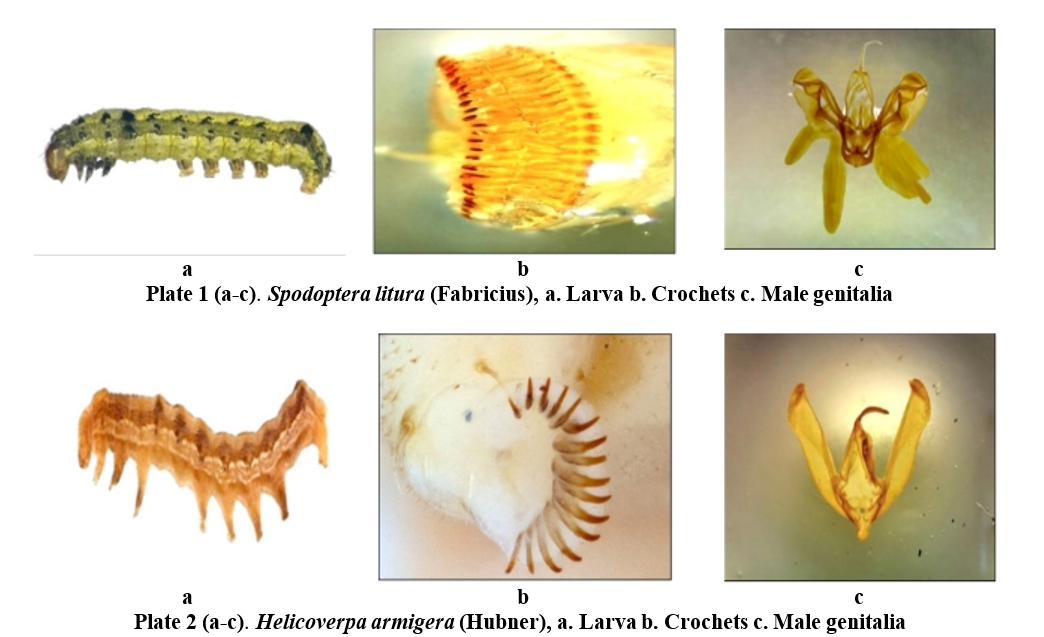
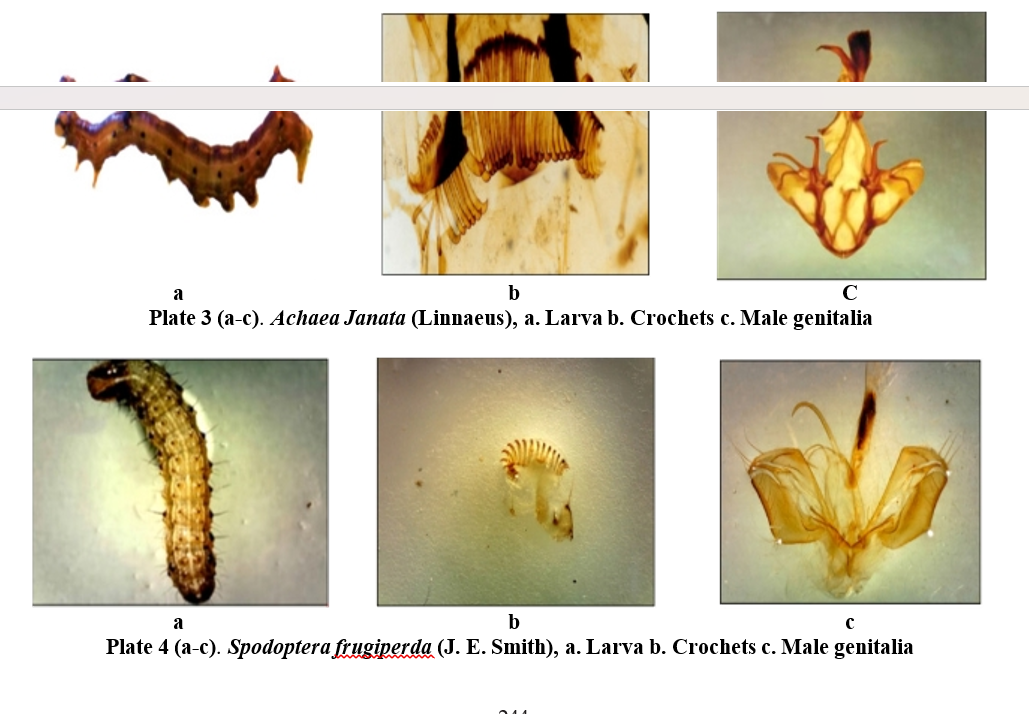
to a pointed apex. Tegumen is slightly sclerotized and inverted V shaped. Female genitalia characterized by elongate ventral plate of ostium bursa.
E. Cotton spotted bollworm, Earias vittella (Fabricius) (Plate 5)
Description of larvae: Larvae is brownish in colour. A longitudinal white stripe is present on the dorsal side of the body and orange maculae all over the body. On pinaculae few setae are present.
Chaetotaxy of prothorax and mesothorax Prothorax: Prothoracic shield much sclerotized
and dark which is extended upto XD2. Dorsal setae D1,
D2 and anterior dorsal setae XD1 and XD2 are distinct. Microscopic seta MXD1 is present. Above the spiracle lateral setae L1, L2 and L3 are present. Ventral seta V1 and subventral setae SV1 and SV2 present.
Mesothorax: Microscopic setae MXD1, MXD2 and Dorsal setae D1 and D2 distinct. Subdorsal setae SD1 and SD2 are also present. Lateral setae L1, L2 and L3 are
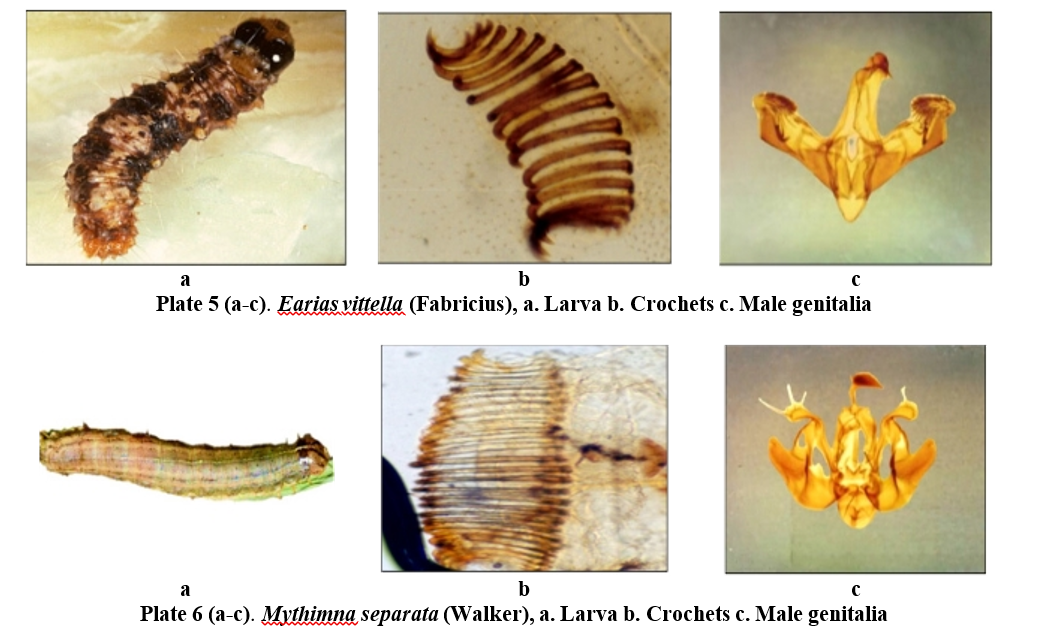
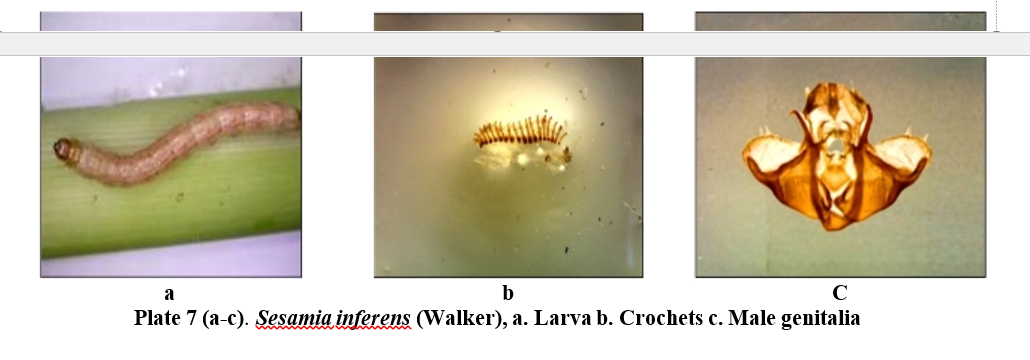
present above the spiracle. Microscopic setae MV1, MV2 setae L1 present below the spiracle, away from L1. Sub and MV3 distinct. Ventral seta V1 and subventral setae ventral setae SV1 distinct. SV1 and SV2 present.
Abdomen: Abdomen ten segmented. Abdominal observed on both abdominal and prolegs. legs are fleshy, paired non-segmented which are called prolegs exists on 3rd, 4th, 5th, 6th and on last segments. Eight pairs of spiracles present on first to eight abdominal segments.
Chaetotaxy of 3rd abdominal segment: Third abdominal segment with subdorsal setae SD1 and SD2 present above the spiracle. Dorsal seta D1 positioned anterodorsally from D2. Lateral seta L1 present nearer to the spiracle. Subventral setae SV1 and SV2 distinct.
Crochets: Uniordinal mesoseries type of crochets are observed on abdominal prolegs.
Description of Adult: Adult moth can be identified by the presence of pale whitish with a broad greenish band running from the base to the apical margin on forewings. The hindwings are whitish in colour. In male genitalia, uncus is bifid and the gnathos is absent. Valvae are rectangular with a well-developed cucullus. In female genitalia, ovipositor lobe is large and densely setose.
F.Rice climbing cutworm, Mythimna separata (Walker) (Plate 6)
Description of larvae: The larvae have two dark brown and white lateral stripes and a central dark brown line. Larvae dirty pale brown in colour and the head is greyish brown in colour
Chaetotaxy of prothorax and mesothorax:
Prothorax: Much sclerotized prothoracic shield present which is dark and extended upto the ventral
margin XD1, MXD1 and XD1 lie in the same vertical line. Dorsal setae D1, subdorsal setae SD1 and SD2 distinct. Two lateral setae L1 and L2 located anterior to the spiracle on the same vertical line. Subventral setae SV1 and SV2 distinct.
Mesothorax: The same vertical line is occupied by the dorsal setae D1 and D2 and the subdorsal setae SD1 and SD2. Subventral seta SV1 distinct and away from L1.
Abdomen: Abdomen ten segmented. Abdominal legs are fleshy, paired non-segmented which are called prolegs exists on 3rd, 4th, 5th, 6th and on last segments. Eight pairs of spiracles present on first to eight abdominal segments.
Cheatotaxy of 3rd abdominal segment: Third
Aabbdovmeitnhael sepgirmacelnet sisubwdiothrsdailstsientcatedSoDrs1apl rsestaenDt.1 LanadteDra2l.
identification of lepidopteran larvae associated with Clark, major field crops in Tirupati district.
Crochets: Uniordinal uniserial type of crochets are observed on both abdominal and prolegs.
Description of Adult: Adult moth can be identified by forewing with a distinctive kidney-shaped (reniform) spot and a circular (orbicular) spot near the center.
Hindwings are whitish to pale grey, with darker veins and slightly darker fringe along the edges. In male genitalia, uncus very short and tegumen inverted U-shaped. In female genitalia, ductus bursae sclerotized and abruptly curved dorsally with many longitudinal striae.
G.Ragi pink stem borer, Sesamia inferens (Walker) (Plate-7)
Description of larvae: Caterpillar is soft and brown in colour. Head is small and reddish to
brown in colour with prothoracic shield.
Chaetotaxy of prothorax and mesothorax Prothorax: Prothoracic shield much chitinized,
dark extended upto the ventral margin of XD2, dorsal setae D1 distinct, Lateral setae L1 and L2 present. Subventral setae SV1 distinct, Ventral setae V1, V2 and V3 are present.
Mesothorax: Dorsal setae D1 distinct and lies in pinaculum. Lateral setae L1 present in a vertical line below D1.
Abdomen: Abdomen ten segmented. Abdominal legs are fleshy, paired non-segmented which are called prolegs exists on 3rd, 4th, 5th, 6th and on last segments.
Eight pairs of spiracles present on first to eight abdominal segments.
Chaetotaxy of 3rd abdominal segment: Third abdominal segment is with dorsal setae D1 and D2 that are arranged in trapezoidal pattern. Subdorsal setae SD1 present just above to the spiracle. Lateral setae L1, L2 and L3 present. Subventral setae SV1, SV2, SV3 distinct.
Crochets: Uniordinal mesoseries heteroideous type of crochets are observed on abdominal prolegs.
Bhattacherjee and Gupta (1971), Adamski and Brown (1987), Ahola (1986) and Chatterjee (1967) conducted chaetotaxy studies of various lepidopteran larvae and stressed the need for chaetotaxic and genital studies aiding in identification of economically important lepidoptera larvae which are in line with present studies.
LITERATURE CITED
In this study external morphology of adults and genital characters of adults were explored for accurate identification of lepidopteran larvae associated with Clark, major field crops in Tirupati district.
Ahola, M. 1986. Larvae of European Polia ochsenheimer (Lepidoptera: Noctuidae), with proposals on a subgeneric division and phylogeny. Entomologica Scandinavica. 17(1): 55-74.
Adamski, D and Brown, R.L. 1987. A new Nearctic Glyphidocera with descriptions of all stages (Lepidoptera: Blastobasidae; Symmocinae). Proceedings of the Entomological Society of Washington. 89(2): 329-343.
Arunasri, M. 2006. Taxonomic studies on the different Lepidopteran larvae of economic importance in Guntur District. M.Sc. (Ag.) Thesis, Acharya N.G. Ranga Agricultural University, Hyderabad.
Bhattacherjee, N.S and Gupta, S.L. 1971. Identity of lepidopterous pests infesting wheat crop at Delhi. Indian Journal of Entomology. 33 (4): 435-451.
Chatterjee, S.N. 1967. The identity of Spodoptera mauritia (Guenee), Spodoptera pecten (Guenee) and Spodoptera abyssinia (Guenee). (Lepidoptera: Noctuidae) based on a comparative study of the male and female genitalia. Indian National Science Academy. 35 (1): 45-58.
G.J.F. 1941. The preparation of slides of the genitalia of Lepidoptera. Bulletin of Brooklyn Entomological Society. 36-53.
Heppner, J.B. 1991. Faunal regions and diversity of Lepidoptera. Tropical Lepidoptera. 2: 1-85.
Kirti, J.S and Gill, N.S. 2005. Taxonomic studies on Indian species of genus Maruca (Walker) (Lepidoptera: Pyralidae: Pyraustinae). Zoos Print Journal. 20(7): 1930-1931.
Regier, J.C., Zwick, A and Cummings, M.P. 2009. Toward reconstructing the evolution of advanced moths and butterflies (Lepidoptera: Ditrysia) an initial molecular study. Evolutionary Biology. 9: 280–300.
- Production Potential of Sweet Corn as Influenced by Organic Manures and Foliar Nutrition
- Characterization of Grain Iron and Zinc Content in Little Millet Genotypes
- Faunistic Studies on Economically Important Lepidopterans in Different Field Crops of Tirupati District
- An Annotated Checklist of Cyperceae, Eriocaulaceae and Potamogetonaceae of Chhattisgarh
- Genetic Divergence Studies for Yield, Yield Components and Resistance to Late Leaf Spot in Groundnut (Arachis Hypogaea L.)
- Effect of Organic Farming on Soil Enzymatic Activity and Productivity of Groundnut Based Cropping System

